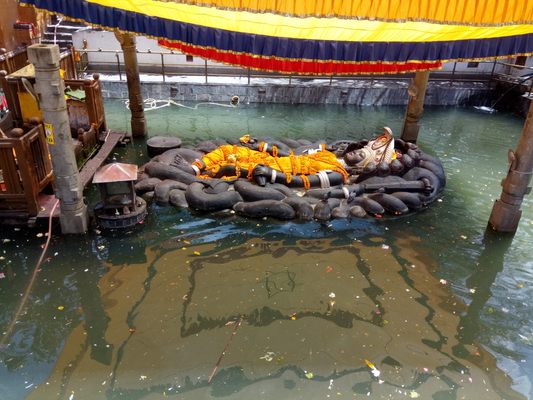About
Nestled in the Himalayan foothills well north of Kathmandu’s city center is a wholly remarkable Hindu temple. The site pays homage to Vishnu (Narayan) whose likeness floats on the sea of bliss reclining upon the multi-headed snake Shesh. It's believed the 16-foot (5-meter) long sculpture made from a single block of basalt, was created during the 6th-century CE by Vishnugupta, an early king of the Kathmandu Valley.
Dedication to the worship of Vishnu at this temple varied over the centuries and was rediscovered periodically by devotees. Today, it's an important religious center for thousands of pilgrims who visit every year during Haribondhini Ekadashi. This sacred event is held during the 11th day of the Hindu month of Kartik (October – November). The event marks the end of the four-month period of Chaturmas, during which Vishnu is believed to sleep.
As a member of the Hindu triad along with Shiva and Brahma, Vishnu represents goodness and preservation. Some Hindus believe that Buddha was an incarnation of Vishnu, and some Buddhists venerate Vishnu as a protector of Buddhism. Regardless of the connection, the name Budhanilkantha has nothing to do with Buddha. Perhaps more confusingly, Vishnu has over a thousand different names, but Budhanilakantha is not one of them. Sanskrit for “Old Blue Throat,” Budhanilakantha is actually one of the names for Lord Shiva.
The origin of the name lies in legends that discuss the struggles between gods and demons that accidentally released a poison from the ocean of existence, requiring intercession by Shiva. To save the world, Shiva drank the poison and then quenched his burning throat with the waters of Lake Gosainkund. The poison left a blue bruise on his throat, hence the name Budhanilkantha. The water surrounding the recumbent Vishnu at the temple is believed to be from Lake Gosainkund, and the faithful believe that a mirror image of Shiva lies on the underside of the sculpture.
Despite the complexity of Vaishnavism nomenclature, the temple itself is a visual delight, frequently adorned with colorful flowers and tika powder. It's also surrounded by classic Nepali and Newari architecture in a paradigmatic Himalayan neighborhood.
Related Tags
Published
October 28, 2020


































